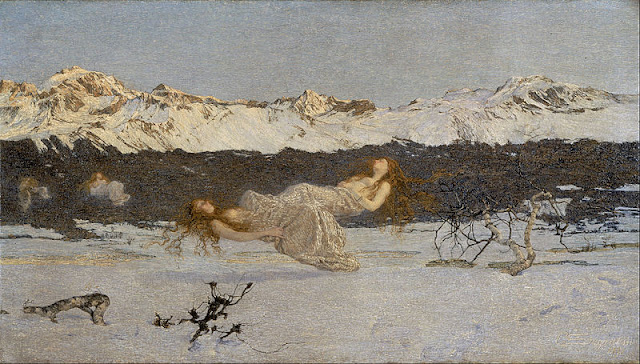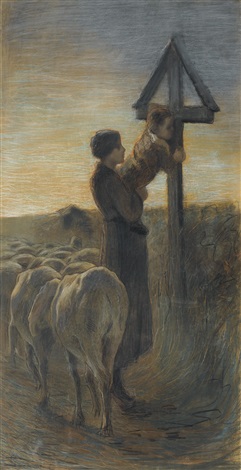Segantini's Punishment of Lust was an early entry in a thematic series on cattive madri (bad mothers) that he produced between 1891 and 1896 (the Nirvana cycle). Taking its inspiration from Nirvana published in 1889 – a translation from the 12th-century Indian Panghiavahli of Maironpada, it shows women being punished for preferring a life of ease over a life of duty by being suspended among the barren landscape of the Alps.
Irene hoped to improve her life by moving to Milan, and in late 1865 she submitted an application to relinquish Austrian citizenship for both her brother and her.
At age seven, Segantini ran away and was later found living on the streets of Milan. The police committed him to the Marchiondi Reformatory, where he learned basic cobbling skills. A chaplain at the reformatory noticed that he could draw quite well, and he encouraged this talent in an attempt to lift his self-esteem.
In 1873, Segantini's half-brother Napoleon claimed him from the reformatory, and for the next year Segantini lived with Napoleon in Trentino. Napoleon ran a photography studio, and Segantini learned the basics of this relatively new art form.
The following year, Segantini returned to Milan and attended classes at the Brera Academy. While there, he became friends with members from a transformative movement known as Scapigliatura.
His first major painting, The Chancel of Sant Antonio (Il Coro di Sant'Antonio), was noticed for its powerful quality, and in 1879 it was acquired by Milan's Società per le Belle Arti. That work attracted the attention of painter and gallery owner Vittore Grubicy de Dragon, who became his advisor, dealer and his life-long financial supporter.
That same year, he met Bugatti's sister, Luigia Pierina Bugatti (1862–1938), known as "Bice", and they began a life-long romance. Segantini was thoroughly devoted to Bice throughout his life.
In 1880, he and Bice moved to Pusiano and soon thereafter to the village of Carella, where they shared a house with their friend Longoni. It was in this mountain scenery that Segantini began to paint en plein air, preferring to work in the outdoors than in a studio. While he worked outside, Bice would read to him, and eventually he learned to read and write. Later he would write articles for Italian art magazines, and he was a prolific letter writer to Bice when he traveled and to other artists throughout Europe.
At this time, he painted the first version of Ave Maria (Segantini Museum, St. Moritz), which took a gold medal at the 1883 World's Fair in Amsterdam. As his fame rose, Segantini entered into a formal agreement with the Grubicys to be the sole representatives of his work. While this allowed Segantini more freedom to pursue his artistry, the dealers were consistently slow in fulfilling their financial obligations to the artists. The family struggled for many years in relative poverty.
During this period Segantini produced several important paintings using Baba as a model, including Mothers, After a Storm in the Alps, A Kiss and Moonlight Effect (Musée des Beaux-Arts, Rouen).
In 1886, Segantini moved his family to Savognin, Graubünden. From November, 1886, to March, 1887, Grubicy stayed with the Segantinis in their new home. Grubicy suggested that Segantini further separate his colors in order to increase their brilliance, he Divisionist painting technique. The artist applied this advice. His bolder style was immediately acclaimed by audiences; Segantini received gold medals in Munich (for Midday in the Alps) and Turin (for Ploughing). The following year the Walker Art Gallery in Liverpool purchased his major painting, The Punishment of Lust.
He moved his family to the Engadin valley in another part of Switzerland. There the high mountain passes and clear light become his chief subject matter for the next five years.
He began to study philosophy, concentrating on those writers who questioned the meaning of life and one's place in the natural world. He became so fascinated with Nietzsche, that he drew an illustration for the first Italian translation of Thus Spoke Zarathustra.
He made the acquaintance of Giovanni Giacometti, father of Alberto Giacometti, and an artist in his own right. Giacometti would later paint a portrait of Segantini on his death bed and complete some of Segantini's unfinished works posthumously.
In 1897, Segantini was commissioned by a group of local hotels to build a huge panorama of the Engadin valley. Segantini designed the concept into a large triptych known as Life, Nature and Death, which is now his most famous work. He continued to work on it until his death.
Segantini's importance as an international artist was further established that same year, when the Austrian state financed a luxury monograph on his work. Museums throughout Europe vied to buy his paintings, including The Comfort of Faith, and The Bad Mothers.
Eager to finish the third part of his large tryptich, Nature (Segantini Museum, St. Moritz) Segantini returned to the high altitude of the mountains near Schafberg. The pace of his work, coupled with the high altitude, affected his health, and in mid-September he became ill with acute peritonitis. Two weeks later he died. His son Mario and his partner Bice were with him at his death bed. More on Giovanni Segantini
Please visit my other blogs: Art
Collector, Mythology, Marine
Art, Portrait of a Lady, The
Orientalist, Art of the Nude and The
Canals of Venice, Middle
East Artists, 365
Saints and 365 Days, also visit my Boards on Pinterest
Images are copyright of their respective owners, assignees or others.
Some Images may be subject to copyright
I don't own any of these images - credit is always given when due unless
it is unknown to me. if I post your images without your permission, please tell
me.
I do not sell art, art prints, framed posters or reproductions. Ads are
shown only to compensate the hosting expenses.
If you enjoyed this post, please share with friends and family.
Thank you for visiting my blog and also for liking its posts and pages.
Please note that the content of this post primarily consists of articles
available from Wikipedia or other free sources online.























.jpg)

No comments:
Post a Comment